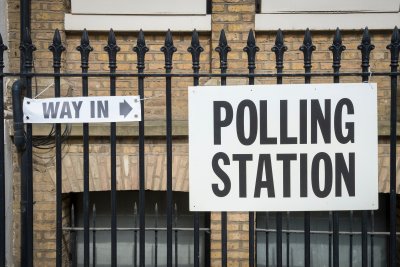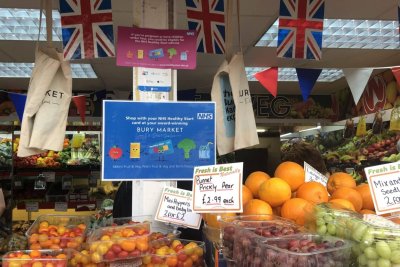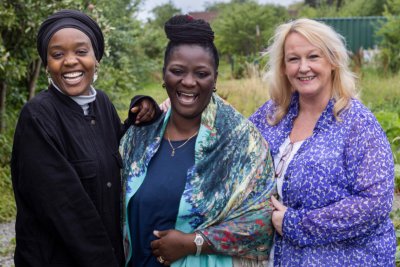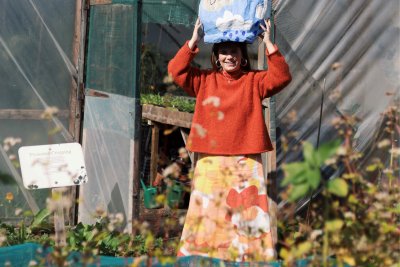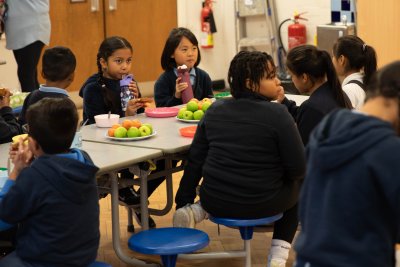How can we grow the good food movement?
Following a joint Sustain and Sustainable Food Places webinar exploring how we can help grow the good food movement be a vibrant, diverse force for change, Sustain's Cecily Spelling & Vera Zakharov reflect on lessons learnt.
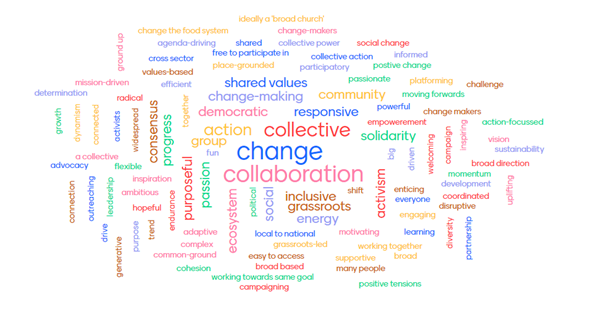
Sustain, as an an alliance working to ensure everyone has access to food that protects people, animals and planet, along with the Sustainable Food Places network of partnerships, working to transform local food systems, both have good food movements at their core. These movements are helping us to both build a constituency of support and achieve change. So given the vital role the movement plays in our work, we joined forces to explore what the movement really is, who is building it and how we can work together to grow it further.
What is a Movement?
To kick off, we must go back to the basics and look at what a movement really means. People at a recent webinar were asked what words they use to describe a movement. Common themes emerged, including collaboration, change, endurance, outreach and uplifting. All fitting words to describe a movement, showcasing the collaboration needed, the purpose and the drive for change that bring us together and keeps us going.
To borrow a definition from Racial Equality Tools, movement-building is the process of organising and helping to activate the will and capacity of people and organisations to work individually or collectively toward a vision they all share. Movement building vests its power in people and organisations so they can take the work wherever it needs to go.
We also invited people at the webinar to share when they have felt part of a movement. People highlighted the feminist movement and fighting fracking, but for many people it was also being part of the good food movement - an eclectic, inspiring, complex system of organisations, groups and community activists working to build a better, fairer food system that benefits both people and planet. Yet are we as diverse as we could be? Certainly not! Could we benefit from a wider range of views? Without a doubt. Are we connecting across siloes to achieve an even bigger impact? We’re working on that.
We invited speakers from The Social Change Agency, Better Food Traders and Shared Assets to explore some of these questions and share their own work within the movement. Together, with attendees, we identified the following ways to grow the movement so it becomes a diverse force for change, that is led by the people and communities who stand to benefit the most.
1. Understand your movement
To build the movement, we need to understand who is in it, what we’re striving for, how we’re going to get there and what is needed to make that happen. The Social Change Agency have just the tool for that: the movement building canvas. This canvas can be used to identify who is part of your movement; what change is going to happen because of your movement; what you stand for as a movement; where you are taking people; and how to centre people and our collective energy for change at the heart of this journey.
2. Find your community
When asked what word best describes a movement, the words collective, people, community, change-makers and activists all cropped up, indicating a movement is about its people. We need to find those people though and offer them opportunities to engage in the movement that meet them where they are.
A first step is identifying who is already in your movement. Shared Assets worked with Land in Our Names, the Landworkers Alliance and many others to create the Land Justice UK ecosystem map. This identified who was already in their community so they could better understand their movement, identify who was missing and work to grow it further.
Sustainable Food Places aims to bring people together around local good food, but to do that they need to reach out to people and make it as easy as possible for people to get involved. To help make this happen in Bristol, the Bristol Food Network created a new Community Participation Lead post. This role helps engage the local community, working with them to create accessible, enticing opportunities for people to get involved with the local food movement.
Better Food Traders has also found their people by ustilising their existing network of food traders in London. 10 members came together to share a map of the London wide network in their own newsletters. This aimed to encourage their customers to share other veg box schemes with their friends and family that might be able to benefit in other areas so they too can enjoy the better food network.
“Movements grow with hundreds of micro-actions. One of those could be to buy food from a better food trader.”
3. Build resource and infrastructure
Movements are incredible forces for change, but a huge amount of resource and infrastructure is needed to both build and maintain them. To grow the good food movement we must ensure that it has the strong foundations it needs to thrive and this should include resources and infrastructure.
A key resource is funding which is why Sustainable Food Places are providing small funding grants for local food partnerships to trial different engagement approaches and capacity-building models. This will help them understand what works and what can be replicated elsewhere to inspire others to get involved.
Shared Assets are resourcing the movement by allowing other organisations to store their funds in their bank account, including black-led organisation Land In Our Names. This not only builds the resource of smaller organisations, allowing them the space to do their work, but also shares resource across the movement, helping to build connection and collaborative approaches.
As part of their resource building efforts, Better Food Traders has created a learning programme called Do Better Food to provide individuals with the space, support and knowledge they need to join the good food movement as well as advocacy skills to inspire others to help the movement grow.
4. Work collaboratively
Collaboration was one of the most popular words used to describe a movement because its growth depends on collaborative working to unite different people and causes, amplify diverse voices and push for whole system change. The Social Change Agency, Sustainable Food Places, Better Food Traders and Shared Assets all came about because of a desire to work collaboratively to offer a solution to a problem – be that creating local food networks working toward long-term change, support for local ethical food businesses or linking up different movements across a common theme to harness collective power.
Shared Assets highlighted the need to work across siloes and not pitch our causes against each other. For example, we cannot grow food without land and we cannot build housing without land, so we must acknowledge these connections and unite to build an even stronger case for change.
Good Food Cardiff, a member of the Sustainable Food Places network used a people’s assembly to work collaboratively with residents, businesses and others in the Cardiff community to collectively reimagine the future of food in Cardiff and identify opportunities to make it a reality. This approach helped to amplify the voices of those who were going to benefit the most and created a sense of ownership over the project.
What next?
The above list is just a snippet of the ways we can grow the good food movement and we’re all learning as we go about what does and doesn’t work. By working together though we can make sure we’re finding our communities, building resources and infrastructure and working collaboratively to inspire change.
If you’d like to get involved in the good food movement you can:
- Sign up the Sustain newsletter to find out about the latest projects and campaigns within the good food movement
- Check out our speakers: The Social Change Agency, Better Food Traders, Shared Assets and Sustainable Food Places
- Check out the Movement Building Canvas and see how it could help you
- Reflect on what a movement means to you and let us know – we’d love to hear from you.
Cecily is Sustain's lead on the Food Learning Forum and Vera is part of the Sustainable Food Places team at Sustain.
Published Wednesday 6 October 2021
Food Learning Forum: The Food Learning Forum is a peer-learning network of food focused organisations that connects and develops the food and farming sector through learning, development and peer discussion.
